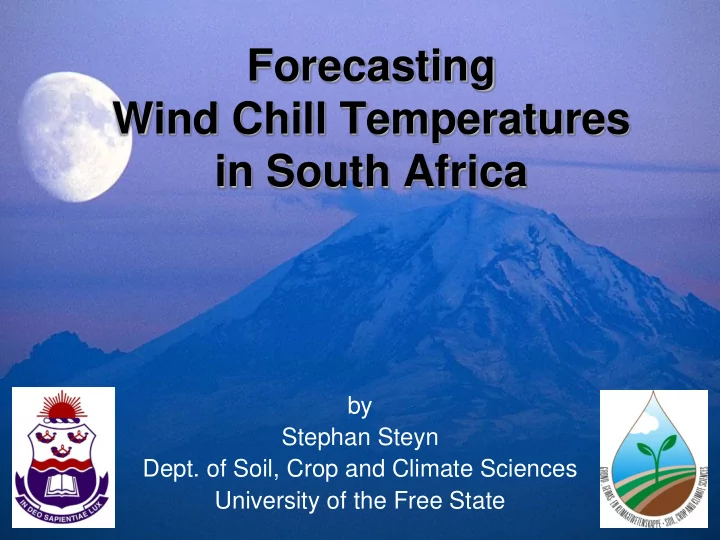

Forecasting Wind Chill Temperatures in South Africa by Stephan Steyn Dept. of Soil, Crop and Climate Sciences University of the Free State
Air Temperature and Human Comfort • The human body’s perception of temperature changes with varying atmospheric conditions • The reason for these changes is related to how we exchange heat energy with our environment • There is a constant exchange of heat – especially at the surface of the skin – between the body and the environment • To maintain a constant temperature, the heat produced and absorbed by the body must be equal to the heat it loses to its surroundings
Sensible Temperature • On a cold day, a thin layer of warm air molecules forms close to the skin • This air layer protects the skin from the surrounding cooler air and from the rapid transfer of heat • Thus, in cold weather, when the air is calm, the temperature we perceive is often higher than a thermometer might indicate • Once the wind starts to blow, the insulating layer of warm air is swept away • Heat is rapidly removed from the skin by the constant bombardment of cold air
Sensible Temperature • In cold weather, the peripheral blood vessels of the body constrict to counteract rapid heat loss to the environment • In hot weather, the blood vessels enlarge, allowing a greater loss of heat energy to the surroundings • As we perspire sweat evaporates and the skin cools because it supplies the large latent heat of vaporization (about 2.43x10 6 J/kg)
All other factors being the same… The faster the wind blows the greater the heat loss the colder we feel
Frostbite • High winds, in below-freezing air, can remove heat from exposed skin so quickly that the skin may actually freeze and discolour • The freezing of skin usually occurs first on the body extremities (fingers, toes, nose, ears) because they are the greatest distance from the source of body heat
Wind Chill Temperature Index (WCTI) • An attempt to measure the effect of combinations of low temperature and wind on humans or animals • Created as a public health tool to reduce hypothermia, frostbite and other cold-related ailments • When forecasters say the "wind chill is -10 C" they are NOT saying that the chilled object is cooled to -10 C
WCTI: General Limitations The WCTI index is at best a rough estimate, since It doesn’t take into account the following factors: • The fit and type of clothing we wear • The amount of sunshine reaching the body • The actual amount of exposed skin • Whether the skin is wet or dry In addition, the wind chill index can only be used for low temperatures and winds stronger than 5 km/h
History of the WCTI • During the 1940s, Paul Siple and Charles Passel conducted experiments in Antarctica • They measured the time needed to freeze water in a plastic cylinder that was exposed to the elements • They found that the time depended on how warm the water was, the outside temperature and the wind speed • Produced an empirical formula: ( 0 . 2135 0 . 2637 0 . 0183 )( 1 . 8 59 . 4 ) 33 WVTI V V T where: V = wind speed in km/h T = air temperature in C
Problems with the old WCTI • Human skin freezes at a different rate than water (different parts of the body freeze at different rates) • The official wind measurements used in the old formula are taken 10 m above ground, where wind blows much faster than it does at the surface • The index-values become unreliable at high wind speeds (cut-off at 40 km/h)
The old WCTI 15 10 5 0 0 10 20 30 40 50 60 70 80 90 100 WCT-index (ºC) -5 10 ºC 5 ºC -10 0 ºC -15 -5 ºC -10 ºC -20 -25 -30 -35 -40 Wind speed (km/h)
The new WCTI • In 2001, the U.S. National Weather Service and the Canadian Weather Service replaced the formulas with new ones • The new formula use "modern heat-transfer theory" instead of empirical equations based on the 1945 experiments • Wind speeds used in the new formula are from winds 1.5 m above the ground ( http://www.weather.gov/om/windchill )
( http://www.weather.gov/om/windchill )
The new WCTI • New WCTI formula: 0 . 16 0 . 16 13 . 12 0 . 6215 11 . 37 ( ) 0 . 3965 ( ) WVTI T V T V where: V = wind speed in km/h T = air temperature in C 15 10 5 0 0 10 20 30 40 50 60 70 80 90 100 WCT-index (ºC) -5 10 ºC 5 ºC -10 0 ºC -15 -5 ºC -10 ºC -20 -25 -30 -35 -40 Wind speed (km/h)
Applying the WCTI to Observed Data Calculations based on 12:00Z data for 2 August 2006 Screen WCTI WCTI Station 10m Wind Temp old new (km/h) (ºC) (ºC) (ºC) Bloemfontein 18.5 5 -9.5 1.3 Cradock 27.8 7 -8.2 2.9 De Aar 46.3 7 -7.7 1.7 Ermelo 37.0 6 -10.1 0.9 Kimberley 37.0 5 -11.6 -0.4 (data supplied by SAWS)
Applying the WCTI to Model Data CCAM prognosis for 06:00Z on 2 August 2006 Temperature difference (ºC) Temperature (ºC) Temperature difference (ºC) Wind speed (km/h) Temperature difference (ºC) (model data courtesy of the UP modelling group)
Concluding Remarks • The new WCTI can be applied with ease to observed data and numerical model fields • Knowledge of the general limitations is crucial for interpretation of the WCTI • Standardisation of the WCTI among the meteorological community is necessary in order to provide an accurate and consistent measure to ensure public safety
Recommend
More recommend